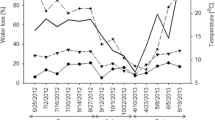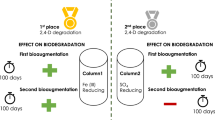Abstract
Purpose
Best management practices encompass diverse artificial groundwater recharge (AGR) systems that heavily rely upon the capacity of the soil and vadose zone to retain large quantities of organic matter generated during stormwater runoff on urban catchments. However, the supply of stormwater-derived dissolved organic carbon (DOC) at the water-table region of aquifers can enhance the rate of biogeochemical processes by fueling heterotrophic microbial metabolism. This study examined changes in the abundance and activity of sediment biofilm in response to increased DOC supply at the water table of an urban aquifer intentionally recharged with stormwater. Changes in microbial abundance and activity under field conditions were compared with those measured in laboratory slow filtration columns supplied with an easily biodegradable source of DOC.
Materials and methods
Biomass and activities of attached bacteria were measured on aquifer sediment samples collected at multiple depths below the groundwater table. The same microbial variables were measured on aquifer sediments introduced in slow filtration columns supplied with three distinct concentrations of biodegradable dissolved organic carbon (0.5, 1.5, and 2.5 mg l−1 of C-acetate).
Results and discussion
Biofilm was significantly more abundant and active beneath AGR sites than at control sites not intentionally recharged with stormwater. Individual cells also exhibited higher specific dehydrogenase and hydrolytic activities, and the protein content of biofilm was significantly increased by AGR with stormwater. The stimulation of the microbial community was all the more pronounced when the flux of DOC reaching the groundwater table was high. However, the increase in microbial biomass and activity at AGR sites was 7.5 times lower than that measured in slow filtration columns in which aquifer sediments were supplied with an easily biodegradable source of DOC.
Conclusions
Our results indicated that the soil and vadose zone at AGR sites efficiently retained the more labile fraction of DOC, thereby enabling the infiltration of large quantities of stormwater without excessively stimulating the growth of microbial biofilm in groundwater. However, our results showed that groundwater bacterial activity was stimulated by enhanced DOC fluxes. As microorganisms experience severe organic carbon limitation in most pristine aquifers, we suggest that groundwater biofilms could be used as sensitive indicators for assessing the DOC fluxes reaching aquifers.






Similar content being viewed by others
References
Allison DG, Ruiz B, San Jose C, Jaspe A, Gilbert P (1998) Extracellular products as mediators of the formation and detachment of Pseudomonas fluorescens biofilms. FEMS Microbiol Lett 167:179–184
Arnold CP, Gibbons CJ (1996) Impervious surface coverage: the emergence of a key environmental indicator. J Am Plann Assoc 62(2):243–258
Battin TJ, Sengschmitt D (1999) Linking sediment biofilms, hydrodynamics, and river bed clogging: Evidence from a large river. Microb Ecol 37:185–196
Bengtsson G (1989) Growth and metabolic flexibility in groundwater bacteria. Microb Ecol 18(3):235–248
Bou C, Rouch R (1967) Un nouveau champ de recherches sur la faune aquatique souterraine. CR Acad Sci Paris 265:369–370
Burt TP, Trudgill ST (1993) Nitrate in groundwater. In: Burt TP et al (eds) Nitrate: processes, patterns and management. Wiley, Chichester, pp 213–238
Christensen JB, Jensen DL, Christensen TH (1996) Effect of dissolved organic carbon on the mobility of cadmium, nickel and zinc in leachate polluted groundwater. Water Res 30:3037–3049
Costerton JW, Lewandowski Z, Caldwell DE, Korber DR, Lappin-Scott HM (1995) Microbial Biofilms. Annu Rev Microbiol 49:711–745
Datry T, Malard F, Gibert J (2004) Dynamics of solutes and dissolved oxygen in shallow urban groundwater below a stormwater infiltration basin. Sci Total Environ 329:215–229
Dubois M, Gilles KA, Hamilton JK, Rebers PA, Smith F (1956) Colorimetric method for determination of sugars and related substances. Anal Chem 28:350–356
Durmaz B, Sanin FD (2001) Effect of carbon to nitrogen ration on the composition of extracellular polymers in activated sludge. Water Sci Technol 44:221–229
Fagerbakke KM, Heldal M, Norland S (1996) Content of carbon, nitrogen, oxygen, sulfur and phosphorus in native aquatic and cultured bacteria. Aquat Microb Ecol 10:15–27
Findlay SEG, Sinsabaugh RL, Sobczak WV, Hoostal M (2003) Metabolic and structural response of hyporheic microbial communities to variations in supply of dissolved organic matter. Limnol Oceanogr 48(4):1608–1617
Fischer D, Charles EG, Baehr AL (2003) Effects of stormwater infiltration on quality of groundwater beneath retention and detention basins. J Environ Eng-ASCE 129(5):464–471
Foulquier A, Malard F, Barraud S, Gibert J (2009) Thermal influence of urban groundwater recharge from stormwater basins. Hydrol Process 23(12):1701–1713
Foulquier A, Malard F, Mermillod-Blondin F, Datry T, Simon L, Montuelle B, Gibert J (2010) Change in dissolved organic carbon and oxygen at the water table region of an aquifer recharged with stormwater: biological uptake or mixing? Biogeochemistry 99:31–47
Freeman C, Lock MA (1995) The biofilm polysaccharide matrix: A buffer against changing organic substrate supply? Limnol Oceanogr 40(2):273–278
Goldscheider N, Hunkeler D, Rossi P (2006) Review: Microbial biocenoses in pristine aquifers and an assessment of investigative methods. Hydrogeol J 14(6):926–941
Griebler C, Mindl B, Slezak D, Geiger-Kaiser M (2002) Distribution patterns of attached and suspended bacteria in pristine and contaminated shallow aquifers studied with an in situ sediment exposure microcosm. Aquat Microb Ecol 28:117–129
Holden PA, Fierer N (2005) Microbial processes in the vadose zone. Vadose Zone J 4:1–21
Houri-Davignon C, Relexans JC, Etcheher H (1989) Measurements of actual electron transport system (ETS) activity in marine sediments by incubation with INT. Environ Technol 10:91–100
Jørgensen PE, Eriksen T, Jensen BK (1992) Estimation of viable biomass in wastewater and activated sludge by determination of ATP, oxygen utilization rate and FDA hydrolysis. Water Res 26(11):1495–1501
Kazumi J, Capone DG (1994) Heterotrophic microbial activity in shallow aquifer sediments of Long Island, New York. Microb Ecol 28(1):19–37
Kolehmainen RE, Langwaldt JH, Puhakka JA (2007) Natural organic matter (NOM) removal and structural changes in the bacterial community during artificial groundwater recharge with humic lake water. Water Res 41(12):2715–2725
Kolehmainen RE, Korpela JP, Münster U, Puhakka JA, Tuovinen OH (2009) Extracellular enzyme activities and nutrient availability during artificial groundwater recharge. Water Res 43(2):405–416
Malard F, Hervant F (1999) Oxygen supply and the adaptations of animals in groundwater. Freshwater Biol 41:1–30
Marmonier P, Fontvieille D, Gibert J, Vanek V (1995) Distribution of dissolved organic carbon and bacteria at the interface between the Rhone River and its alluvial aquifer. J N Am Benthol Soc 14(3):382–392
Marsalek J, Chocat B (2002) International report: Stormwater management. Water Sci Technol 46(6–7):1–17
Maurines-Carboneill C, Pernelle JJ, Morin L, Sachon G, Leblon G (1998) Relevance of the INT test response as an indicator of the ETS activity in monitoring heterotrophic aerobic bacterial populations in activated sludges. Water Res 32:1213–1221
Mermillod-Blondin F, Mauclaire L, Montuelle B (2005) Use of slow filtration columns to assess oxygen respiration, consumption of dissolved organic carbon, nitrogen transformations, and microbial parameters in hyporheic sediments. Water Res 39(9):1687–1698
Michalzik B, Kalbitz K, Park JH, Solinger S, Matzner E (2001) Fluxes and concentrations of dissolved organic carbon and nitrogen - a synthesis for temperate forests. Biogeochemistry 52(2):173–205
Miettinen IT, Vartiainen T, Martikainen PJ (1996) Bacterial enzyme activities in ground water during bank filtration of lake water. Water Res 30(10):2495–2501
Molz FJ, Widdowson MA, Benefield LD (1986) Simulation of microbial growth dynamics coupled to nutrient and oxygen transport in porous media. Water Resour Res 22(8):1207–1216
Niemczynowicz J (1999) Urban hydrology and water management - present and future challenges. Urban Water J 1(1):1–14
Pabich WJ, Valiela I, Hemond HF (2001) Relationship between DOC concentration and vadose zone thickness and depth below water table in groundwater of Cape Cod, U.S.A. Biogeochemistry 553:247–268
Peterson GL (1977) A modification of the protein assay method of Lowry et al. which is more generally applicable. Anal Biochem 83(2):346–356
Porter KS, Feig YS (1980) The use of DAPI for identifying and counting aquatic microflora. Limnol Oceanogr 25(5):943–948
R Development Core Team (2006) R: a language and environment for statistical computing. R Foundation for Statistical Computing: Vienna. http://www.R-project.org
Rauch-Williams T, Drewes JE (2006) Using soil biomass as an indicator for the biological removal of effluent-derived organic carbon during soil infiltration. Water Res 40(5):961–968
Reeve CA, Bockman AT, Matin A (1984) Role of protein degradation in the survival of carbon-starved Escherichia coli and Salmonella typhimurium. J Bacteriol 157(3):758–763
Schönholzer F, Hahn D, Zeyer J (1999) Origins and fate of fungi and bacteria in the gut of Lumbricus terrestris L. studied by image analysis. FEMS Microbiol Ecol 28:235–248
United Nations, Department of Economic and Social Affairs, Population Division (2007) World Population Prospects: The 2006 Revision, Highlights. Working Paper No. ESA/P/WP.202. United Nations, New York
US EPA (1991) Methods for measuring the acute toxicity of effluents and receiving waters to freshwater and marine organisms. Report EPA/600/4–90/27, 4th edn. U.S. Environmental Protection Agency, Washington, DC
Vrede K, Heldal M, Norland S, Bratbak G (2002) Elemental composition (C, N, P) and cell volume of exponentially growing and nutrient-limited bacterioplankton. Appl Environ Microbiol 68:2965–2971
Watson SP, Clements MO, Foster SJ (1998) Characterization of the starvation-survival response of Staphylococcus aureus. J Bacteriol 180(7):1750–1758
Wilson JT, McNabb JF, Balkwill DL, Ghiorse WC (1983) Enumeration and characterization of bacteria indigenous to shallow water-table aquifer. Ground Water 21(2):134–142
Acknowledgements
This study was conducted within the framework of the experimental observatory for urban hydrology (OTHU, http://www.graie.org/othu/). It was funded by the French National Research Agency (project ANR-05-ECOT-006; http://www.graie.org/ecopluies/), the French program EC2CO-Cytrix from INSU/CNRS (project “NAPCOD”), the urban community of Lyon, and the Rhône-Alpes Region. We are indebted to G. Bouger, E. Malet, Y. Negrutiu, L. Simon, P. Potier and F. Vallier for their most dedicated support with the field and laboratory work. We thank Sabine U. Gerbersdorf and two anonymous reviewers for their comments that improved an earlier version of the manuscript.
Author information
Authors and Affiliations
Corresponding author
Additional information
Responsible editor: Sabine Ulrike Gerbersdorf.
Electronic supplementary material
Below is the link to the electronic supplementary material.
ESM 1
(DOC 43 kb)
Rights and permissions
About this article
Cite this article
Foulquier, A., Mermillod-Blondin, F., Malard, F. et al. Response of sediment biofilm to increased dissolved organic carbon supply in groundwater artificially recharged with stormwater. J Soils Sediments 11, 382–393 (2011). https://doi.org/10.1007/s11368-010-0323-2
Received:
Accepted:
Published:
Issue Date:
DOI: https://doi.org/10.1007/s11368-010-0323-2




